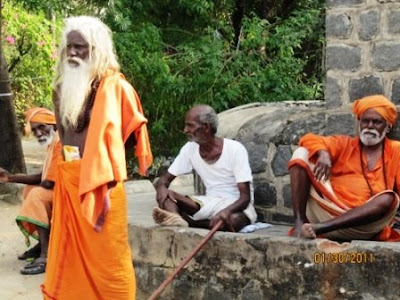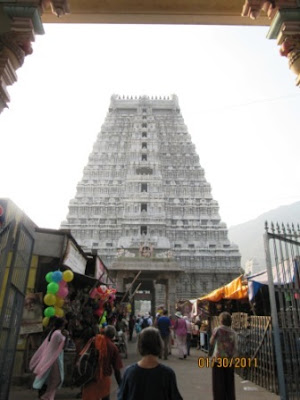




Sunday morning after breakfast a few of us climbed the sacred mountain to the caves, about 1/4 the way up, where the guru stayed so many years. It was a nice hike, great to be outside and away from the crowds. Blankets spread with souvenirs were offered for sale along the way. A would-be guru stopped us to see if we had any questions and to tell his story and give us pictures of the main guru, the same picture we had in our rooms, the same picture on the website, the same one in the previous entry that was on the map sign.
Like the holy sites in Jerusalem and Bethlehem, though not so large nor so antique, the original caves had been enshrined in buildings. We went inside to meditate. In the inner sanctum was that same guru photo with a flame in front of it. People would prostrate themselves before it. After awhile a man started looking like he wanted my spot, which was in a bit of a traffic area anyway, so I got up and went out to the porch and sat where there was a gentle breeze. All around this cave were red-faced monkeys, young ones running and jumping on each other, old ones scanning the passersby for signs of food offerings. One of my companions rattled a plastic bag and one jumped on her back.




 Later in the afternoon we all went to Arunachaleshvara, the enormous main temple in Tiruvannamalai, which we had viewed from the mountain. The guidebook says it was built over the course of a thousand years. (It also says that there is a lingam, or phallic symbol, where our friend Sri Ramana “sat in a state of Supreme Awareness while ants devoured his flesh.” Hmm.) It was a huge complex punctuated by several large towers shaped somewhat like enormous stepladders, ornately carved, maybe twenty stories high. Father Joe compared it with the temple of ancient Jerusalem, and it did seem to function in similar ways, more so than either of them does like a church, synagogue, or mosque. On the outskirts were the vendors, in a covered alleyway, sort of cross between middle eastern souk and midwestern carnival. There was even cotton candy. Flower garlands to buy, oil lamps, toys for the pilgrim kids, bangles, tikkas, street food, DVDs, cookware, cheap plastic stuff, beggers, a lot of overstimulation.
Later in the afternoon we all went to Arunachaleshvara, the enormous main temple in Tiruvannamalai, which we had viewed from the mountain. The guidebook says it was built over the course of a thousand years. (It also says that there is a lingam, or phallic symbol, where our friend Sri Ramana “sat in a state of Supreme Awareness while ants devoured his flesh.” Hmm.) It was a huge complex punctuated by several large towers shaped somewhat like enormous stepladders, ornately carved, maybe twenty stories high. Father Joe compared it with the temple of ancient Jerusalem, and it did seem to function in similar ways, more so than either of them does like a church, synagogue, or mosque. On the outskirts were the vendors, in a covered alleyway, sort of cross between middle eastern souk and midwestern carnival. There was even cotton candy. Flower garlands to buy, oil lamps, toys for the pilgrim kids, bangles, tikkas, street food, DVDs, cookware, cheap plastic stuff, beggers, a lot of overstimulation. At a certain point we left our shoes. We went through a large tunnel-like gateway into the temple itself, the open air part of it. As in the Jerusalem temple, there were outer and inner and very inner and innermost regions. On the outskirts there was an elephant who would bless you by whacking your head with its trunk if you dropped a coin in its nostril. The little children were scared but it seemed to have good business sense, knowing not to whack them too hard. Apparently these elephants work in many large temples. A good gig if you happen to be an elephant and have a human friend who can turn the coins into food without taking too much of your pay.
One of the innermost courts was a building where we processed in a barricaded line to an inner sanctum big enough for 20 people to sit very close. There were two lines with guard rails and we seem to have paid enough to take the express lane, or “special darshan.” Inside there was an altar rail of sorts, and on the other side were some priests tending to fires. It was like the burning heart of the inner sanctuary. We were told to sit (which was good because it was noticeably cooler on the ground), we were all asked to give our names, and then the priests left us to go do some rituals among the flames. At that point it reminded me of the events before and behind the iconostasis in Orthodox churches, or between the altar and the congregation among the Catholics, or in and around the ark among the Jews, or in the holy of holies in the ancient temple. They came back out and told us to come forward one by one. They put ashes on our foreheads and in our hands, and we left the room. We did it again at another sanctuary, only this one involved flowers not fire, and the puja we received on our foreheads was red.
Outdoors in the temple plaza, we were a tourist attraction. Several Indian visitors asked politely if they could pose with us for a picture. Mothers were cuing their school-age children to shake our hands and speak English to us. They all seemed good-naturedly amused with us.
We returned in time for dinner in the ashram, but I decided to treat myself to fig bars and a banana in the room. I am learning that I can follow external regimentation by impersonal forces only as long as it remains a novelty. Perhaps I am the last to find that out about me.
No comments:
Post a Comment